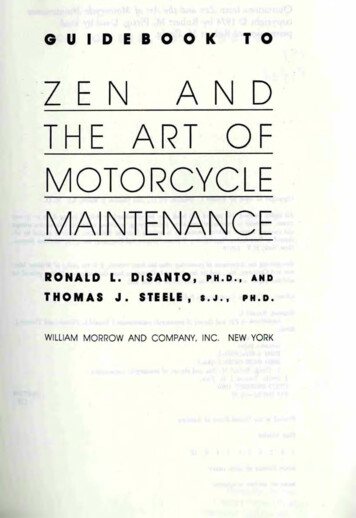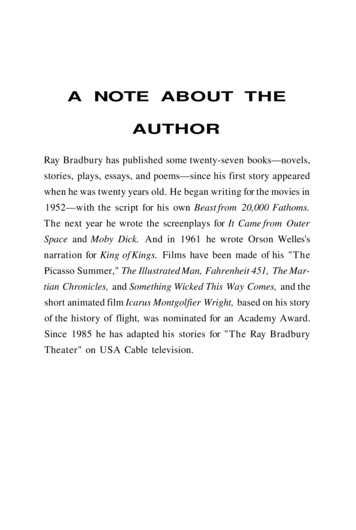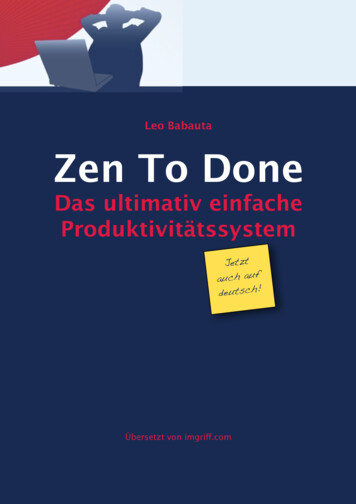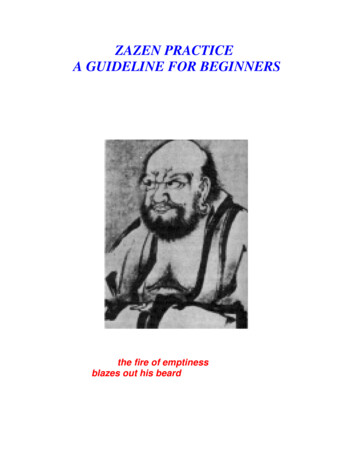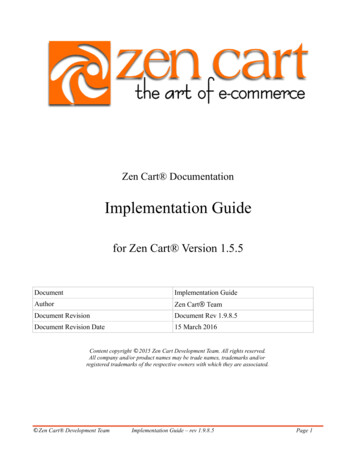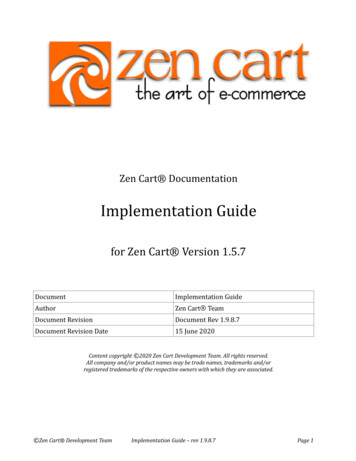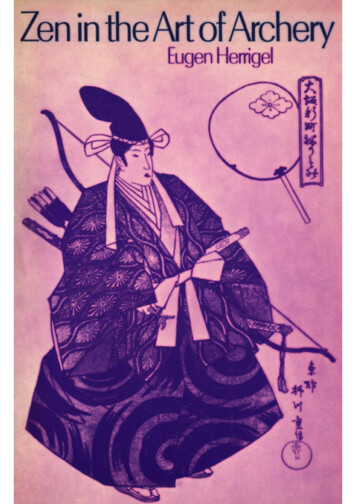
Transcription
ZENIN THE ART OF ARCHERYbyEUGEN HERRIGELTranslated from the German byR. F. C. HULLFirst Published 1953
PREFACEIn 1936 a lecture which I had delivered to the German Japanese Society in Berlin appeared in the magazine Nipponunder the title "The Chivalrous Art of Archery". I had given thislecture with the utmost reserve, for I had intended to show theclose connection which exists between this art and Zen.And since this connection eludes precise description and realdefinition, I was fully conscious of the provisional nature of myattempt.In spite of everything, my remarks aroused great interest.They were translated into Japanese in 1937, into Dutch in 1938,and in 1939 I received news so far unconfirmed that anIndian translation was being planned. In 1940 a much improvedJapanese translation appeared together with an eyewitnessaccount by Prof. Sozo Komachiya.When Curt Weller, who published The Great Liberation,D. T. Suzuki’s important book on Zen, and who is also bringingout a carefully planned series of Buddhist writings, asked mewhether I agreed to a reprint of my lecture, I willingly gave myconsent. But, in the conviction of having made further spiritualprogress during the past ten years and this means ten years ofcontinual practice and of being able to say rather better thanbefore, with greater understanding and realization, what this"mystical" art is about, I have resolved to set down myexperiences in new form. Unforgettable memories and noteswhich I made at the time in connection with the archery lessons,stood me in good stead. And so I can well say that there is noword in this exposition which the Master would not havespoken, no image or comparison which he would not have used.I have also tried to keep my language as simple as possible.Not only because Zen teaches and advocates the greatest
economy of expression, but because I have found that what I cannot say quite simply and without recourse to mystic jargon hasnot become sufficiently clear and concrete even to myself.To write a book on the essence of Zen itself is one of myplans for the near future.EUGEN HERRIGEL
ZENIN THE ART OF ARCHERYIAt first sight it must seem intolerably degrading for Zen however the reader may understand this word to beassociated with anything so mundane as archery. Even if hewere willing to make a big concession, and to find archerydistinguished as an art’, he would scarcely feel inclined to lookbehind this art for anything more than a decidedly sporting formof prowess. He therefore expects to be told something about theamazing feats of Japanese trick artists, who have the advantageof being able to rely on a time honoured and unbroken traditionin the use of bow and arrow. For in the Far East it is only a fewgenerations since the old means of combat were replaced bymodern weapons, and familiarity in the handling of them by nomeans fell into disuse, but went on propagating itself, and hassince been cultivated in ever widening circles. Might one notexpect, therefore, a description of the special ways in whicharchery is pursued to day as a national sport in Japan?Nothing could be more mistaken than this expectation.By archery in the traditional sense, which he esteems as an art andhonours as a national heritage, the Japanese does not understanda sport but, strange as this may sound at first, a religious ritual.And consequently, by the " art " of archery he does not mean theability of the sportsman, which can be controlled, more or less,by bodily exercises, but an ability whose origin is to be soughtin spiritual exercises and whose aim consists in hitting aspiritual goal, so that fundamentally the marksman aims athimself and may even succeed in hitting himself.
This sounds puzzling, no doubt. What, the reader will say, arewe to believe that archery, once practised for the contest of lifeand death, has not survived even as a sport, but has beendegraded to a spiritual exercise? Of what use, then, are the bowand arrow and target? Does not this deny the manly old art andhonest meaning of archery, and set up in its place somethingnebulous, if not positively fantastic?It must, however, be borne in mind that the peculiar spirit ofthis art, far from having to be in fused back into the use of bowand arrow in recent times, was always essentially bound up withthem, and has emerged all the more forthrightly andconvincingly now that it no longer has to prove itself in bloodycontests. It is not true to say that the traditional technique ofarchery, since it is no longer of importance in fighting, hasturned into a pleasant pastime and thereby been renderedinnocuous. The " Great Doctrine " of archery tells us somethingvery different. According to it, archery is still a matter of lifeand death to the extent that it is a contest of the archer withhimself; and this kind of contest is not a paltry substitute, but thefoundation of all contests outwardly directed for instance witha bodily opponent. In this contest of the archer with himself isrevealed the secret essence of this art, and instruction in it doesnot suppress anything essential by waiving the utilitarian ends towhich the practice of knightly contests was put.Anyone who subscribes to this art to day, therefore, will gainfrom its historical development the undeniable advantage of notbeing tempted to obscure his understanding of the "GreatDoctrine" by practical aims even though he hides them fromhimself and to make it perhaps altogether impossible.For access to the art and the master archers of all times areagreed in this is only granted to those who are "pure" in heart,untroubled by subsidiary aims.Should one ask, from this standpoint, how the JapaneseMasters understand this contest of the archer with himself, andhow they describe it, their answer would sound enigmatic in theextreme. For them the contest consists in the archer aiming athimself and yet not at himself, in hitting himself and yetnot himself, and thus becoming simultaneously the aimer and the
aim, the hitter and the hit. Or, to use some expressions which arenearest the heart of the Masters, it is necessary for the archer tobecome, in spite of himself, an unmoved centre. Then comes thesupreme and ultimate miracle: art becomes " artless ", shootingbecomes not shooting, a shooting without bow and arrow; theteacher becomes a pupil again, the Master a beginner, the end abeginning, and the beginning perfection.For Orientals these mysterious formulae are clear and familiartruths, but for us they are completely bewildering. We havetherefore to go into this question more deeply. For someconsiderable time it has been no secret, even to us Europeans,that the Japanese arts go back for their inner form to a commonroot, namely Buddhism. This is as true of the art of archery as ofink painting, of the art of the theatre no less than the teaceremony, the art of flower arrangement, and swordsmanship.All of them presuppose a spiritual attitude and each cultivates itin its own way an attitude which, in its most exalted form, ischaracteristic of Buddhism and determines the nature of thepriestly type of man. I do not mean Buddhism in the ordinarysense, nor am I concerned here with the decidedly speculativeform of Buddhism, which, because of its allegedly accessibleliterature, is the only one we know in Europe and even claim tounderstand. I mean Dhyana Buddhism, which is known in Japanas " Zen " and is not speculation at all but immediate experienceof what, as the bottomless ground of Being, cannot beapprehended by intellectual means, and cannot be conceived orinterpreted even after the most unequivocal and incontestableexperiences: one knows it by not knowing it. For the sake ofthose crucial experiences Zen Buddhism has struck out on pathswhich, through methodical immersion in oneself, lead to one’sbecoming aware, in the deepest ground of the soul, of theunnamable Groundlessness and Qualitylessness nay more, toone’s becoming one with it. And this, with respect to archeryand expressed in very tentative and on that account possiblymisleading language, means that the spiritual exercises, thanksto which alone the technique of archery becomes an art and, ifall goes well, perfects itself as the " artless art ", are mysticalexercises, and accordingly archery can in no circumstances
mean accomplishing anything outwardly with bow and arrow,but only inwardly, with oneself. Bow and arrow are only apretext for something that could just as well happen withoutthem, only the way to a goal, not the goal itself, only helps forthe last decisive leap. In view of all this, nothing would be moredesirable than that one should be able to lay hands onexpositions by Zen Buddhists as an aid to understanding. Theseare in fact not lacking. In his Essays In Zen Buddhism,D. T. Suzuki has succeeded in showing that Japanese cultureand Zen are intimately connected and that Japanese art, thespiritual attitude of the Samurai, the Japanese way of life, themoral, aesthetic and to a certain extent even the intellectual lifeof the Japanese owe their peculiarities to this background of Zenand cannot be properly understood by anybody not acquaintedwith it.The exceedingly important work of Suzuki and the researchesof other Japanese scholars have aroused widespread interest. Itis generally admitted that Dhyana Buddhism, which was born inIndia and, after undergoing profound changes, reached fulldevelopment in China, to be finally adopted by Japan, where itis cultivated as a living tradition to this day, has disclosedunsuspected ways of existence which it is of the utmostimportance for us to understand.Despite all the efforts of Zen experts, however, the insightafforded to us Europeans into the essence of Zen has remainedexceedingly scanty. As though it resisted deeper penetration,after a few steps one’s groping intuition comes up againstinsurmountable barriers. Wrapped in impenetrable darkness,Zen must seem the strangest riddle which the spiritual life of theEast has ever devised: insoluble and yet irresistibly attractive.The reason for this painful feeling of inaccessibility lies, to someextent, in the style of exposition that has hitherto been adoptedfor Zen. No reasonable person would expect a Zen adept to domore than hint at the experiences which have liberated andchanged him, or to attempt to describe the unimaginable andineffable "Truth" by which he now lives. In this respect Zen isakin to pure introspective mysticism. Unless we enter intomystic experiences by direct participation, we remain outside,
turn and twist as we may. This law, which all genuine mysticismobeys, allows of no exceptions. It is no contradiction that thereexists a plethora of Zen texts regarded as sacred. They have thepeculiarity of disclosing their life giving meaning only to thosewho have shown themselves worthy of the crucial experiencesand who can therefore extract from these texts confirmation ofwhat they themselves already possess and are independently ofthem. To the inexperienced, on the other hand, they remain notonly dumb how could he ever be in a position to read betweenthe lines? but will infallibly lead him into the most hopelessspiritual confusion, even if he approaches them with warinessand selfless devotion. Like all mysticism, Zen can only beunderstood by one who is himself a mystic and is therefore nottempted to gain by underhand methods what the mysticalexperience withholds from him.Yet the man who is transformed by Zen, and who has passedthrough the " fire of truth ", leads far too convincing a life for it tobe overlooked. So it is not asking too much if, driven by afeeling of spiritual affinity, and desirous of finding a way to thenameless power which can work such miracles for the merelycurious have no right to demand anything we expect the Zenadept at least to describe the way that leads to the goal.No mystic and no student of Zen is, at first step, the man he canbecome through self perfection. How much has still to beconquered and left behind before he finally lights upon the truth!How often is he tormented on the way by the desolate feelingthat he is attempting the impossible! And yet this impossiblewill one day have become possible and even self evident.Is there not room for the hope, then, that a careful description ofthis long and difficult road will allow us at least one thing:to ask whether we wish to travel it?Such descriptions of the way and its stations are almostentirely lacking in Zen literature. This is partly due to the factthat the Zen adept has an insuperable objection to giving any kindof instructions for the happy life. He knows from personalexperience that nobody can stay the course withoutconscientious guidance from a skilled teacher and without thehelp of a Master. No less decisive, on the other hand, is the fact
that his experiences, his conquests and spiritual transformations,so long as they still remain " his ", must be conquered andtransformed again and again until everything " his " is annihilated.Only in this way can he attain a basis for experiences which, asthe "all embracing Truth" rouse him to a life that is no longerhis everyday, personal life. He lives, but what lives is no longerhimself.From this standpoint we can understand why the Zen adeptshuns all talk of himself and his progress. Not because he thinksit immodest to talk, but because he regards it as a betrayal ofZen. Even to make up his mind to say anything about Zen itselfcosts him grave heart searchings. He has before him the warningexample of one of the greatest Masters, who, on being askedwhat Zen was, maintained an unmoving silence, as though hehad not heard the question. How then could any adept feeltempted to render an account of what he has thrown away andno longer misses?In these circumstances, I should be shirking myresponsibilities if I confined myself to a string of paradoxes andtook refuge behind a barrage of high sounding words. For it wasmy intention to throw light on the nature of Zen as it affects oneof the arts upon which it has set its stamp. This light is certainlynot illumination in the sense fundamental to Zen, but at leastshows that there must be something behind the impenetrablewalls of mist, and which, like summer lightning, heralds thedistant storm. So understood, the art of archery is rather like apreparatory school for Zen, for it enables the beginner to gain aclearer view, through the works of his own hands, of eventswhich are not in themselves intelligible. Objectively speaking,it would be entirely possible to make one’s way to Zen from anyone of the arts I have named.However, I think I can achieve my aim most effectively bydescribing the course which a pupil of the art of archery has tocomplete. To be more precise, I shall try to summarize thesix year course of instruction I received from one of the greatestMasters of this art during my stay in Japan. So it is my ownexperiences which authorize me in this undertaking. In order tomake myself intelligible at all for even this preparatory school
holds riddles enough I have no alternative but to recollect indetail all the resistances I had to overcome, all the inhibitions Ihad to fight down, before I succeeded in penetrating into thespirit of the Great Doctrine. I speak about myself only because Isee no other way of reaching the goal I have set before me.For the same reason I shall confine my account to essentials, soas to make them stand out more clearly. I consciously refrain fromdescribing the setting in which the instruction took place, fromconjuring up scenes that have fixed themselves in my memory,and above all from sketching a picture of the Master howevertempting all this may be. Everything must hinge on the art ofarchery, which, I sometimes feel, is even more difficult toexpound than to learn; and the exposition must be carried to thepoint where we begin to discern those far off horizons behindwhich Zen lives and breathes.
IIWhy I took up Zen, and for this purpose set out to learn theart of archery, needs some explanation. Even as a student I had,as though driven by a secret urge, been preoccupied withmysticism, despite the mood of the times, which had little usefor such interests. For all my exertions, however, I becameincreasingly aware that I could only approach these esotericwritings from the outside; and though I knew how to circlearound what one may call the primordial mystic phenomenon, Iwas unable to leap over the line which surrounded the mysterylike a high wall. Nor could I find exactly what I sought in theextensive literature of mysticism, and, disappointed anddiscouraged, I gradually came to realize that only the trulydetached can understand what is meant by " detachment ", andthat only the contemplative, who is completely empty and rid ofthe self, is ready to " become one " with the " transcendent Deity ".I had realized, therefore, that there is and can be no other way tomysticism than the way of personal experience and suffering,and that, if this premise is lacking, all talk about it is so muchempty chatter. But how does one become a mystic? Howattain the state of real, and not just imaginary, detachment? Isthere still a way to it even for those who are separated by theabyss of the centuries from the great Masters? For the modernman, who has grown up under totally different conditions?Nowhere did I find anything approaching satisfactory answers tomy questions, even though I was told about the stages andstations of a way that promised to lead to the goal. To tread thisway, I lacked the precise methodical in structions which mightsubstitute for a Master, at least for part of the journey. Butwould such instructions, even if there were any, suffice? Is it notmore probable that, at best, they only create a readiness toreceive something which even the best method cannot provide,and that the mystical experience therefore cannot be induced by
any disposition known to man? However I looked at it, I foundmyself confronted by locked doors, and yet I could not refrainfrom constantly rattling at the handles. But the longing persisted,and, when it grew weary, the longing for this longing.When, therefore, I was asked I had in the meantime becomea lecturer at a university whether I would like to teachphilosophy at the University of Tokyo, I welcomed thisopportunity of getting to know the country and people of Japanwith especial joy, if only because it held out the prospect of mymaking contact with Buddhism and hence with an introspectivepractice of mysticism. For this much I had already heard, thatthere was in Japan a carefully guarded and living tradition ofZen, an art of instruction that had been tested over the centuries,and, most important of all, teachers of Zen astonishingly wellversed in the art of spiritual guidance.Scarcely had I begun to find my way about in the new milieuwhen I set out to realize my desire. I at once met withembarrassed refusals. Never yet, I was told, had any Europeanseriously concerned himself with Zen, and since Zen repudiatedthe least trace of " teaching ", it was not to be expected that itwould satisfy me " theoretically ". It cost me many wasted hoursbefore I succeeded in making them understand why I wished todevote myself specifically to the non speculative form of Zen.Thereupon I was informed that it was quite hopeless for aEuropean to attempt to penetrate into this realm of spiritual life perhaps the strangest which the Far East has to offer unlesshe began by learning one of the Japanese arts associated withZen.The thought of having to go through a kind of preparatoryschooling did not deter me. I felt ready to go to any length ifonly there were some hope of my getting a bit nearer to Zen; anda roundabout way, however wearisome, seemed better to methan no way at all. But to which of the arts named for thispurpose should I subscribe? My wife, after a little hesitation,decided for flower arrangement and painting, while the art ofarchery seemed more suitable for me, on the as it later turnedout completely erroneous assumption that my experiences inrifle and pistol shooting would be to my advantage.
I begged one of my colleagues, Sozo Komachiya, a professorof jurisprudence who had been taking lessons in archery fortwenty years and who was rightly regarded as the best exponentof this art at the university, to enter my name as a pupil with hisformer teacher, the celebrated Master Kenzo Awa.The Master at first refused my request, saying that he hadonce been misguided enough to instruct a foreigner and hadregretted the experience ever since. He was not prepared tomake concessions a second time, in order to spare the pupil theburden of the peculiar spirit of this art. Only when I protested thata Master who took his job so seriously could well treat me as hisyoungest pupil, seeing that I wished to learn this art not for pleasurebut for the sake of the "Great Doctrine", did he accept me ashis pupil, together with my wife, since it has long beencustomary in Japan for girls to be instructed in this art, and sincethe Master’s wife and two daughters were diligent practitioners.And so began the long and strenuous course of instruction, inwhich our friend Mr. Komachiya, who pleaded our cause soobstinately and almost stood guarantor for us, participated asinterpreter. At the same time my good fortune in being invited toattend my wife’s lessons in flower arrangement and paintingheld out the prospect of my winning a still broader basis ofunderstanding through constant comparison of these mutuallycomplementary arts.
IIIThat the way of the " artless art " is not easy to follow wewere to learn during the very first lesson. The Master began byshowing us various Japanese bows, explaining that theirextraordinary elasticity was due to their peculiar constructionand also to the material from which they are generally made,namely bamboo. But it seemed even more important to him thatwe should note the noble form which the bow it is over sixfeet long assumes as soon as it is strung, and which appearsthe more surprising the further the bow is drawn. When drawnto its full extent, the bow encloses the "All" in itself, explainedthe Master, and that is why it is important to learn how to drawit properly. Then he grasped the best and strongest of his bowsand, standing in a ceremonious and dignified attitude, let thelightly drawn bowstring fly back several times. This produces asharp crack mingled with a deep thrumming, which one neverafterwards forgets when one has heard it only a few times: sostrange is it, so thrillingly does it grip the heart. From ancienttimes it has been credited with the secret power of banishingevil spirits, and I can well believe that this interpretation hasstruck root in the whole Japanese people. After this significantintroductory act of purification and consecration the Mastercommanded us to watch him closely. He placed, or "nocked",an arrow on the string, drew the bow so far that I was afraid itwould not stand up to the strain of embracing the All, andloosed the arrow. All this looked not only very beautiful, butquite effortless. He then gave us his instructions: "Now you dothe same, but remember that archery is not meant to strengthenthe muscles. When drawing the string you should not exert thefull strength of your body, but must learn to let only your twohands do the work, while your arm and shoulder muscles remainrelaxed, as though they looked on impassively. Only when youcan do this will you have fulfilled one of the conditions thatmake the drawing and the shooting ˆspiritual ." With these
words he gripped my hands and slowly guided them through thephases of the movement which they would have to execute inthe future, as if accustoming me to the feel of it.Even at the first attempt with a medium strong practice-bowI noticed that I had to use considerable force to bend it. This isbecause the Japanese bow, unlike the European sporting bow, isnot held at shoulder level, in which position you can, as it were,press yourself into it. Rather, as soon as the arrow is nocked, thebow is held up with arms at nearly full stretch, so that thearcher’s hands are somewhere above his head. Consequently, theonly thing he can do is to pull them evenly apart to left andright, and the further apart they get the more they curvedownwards, until the left hand, which holds the bow, comes torest at eye level with the arm outstretched, while the right hand,which draws the string, is held with arm bent above the rightshoulder, so that the tip of the three foot arrow sticks out a littlebeyond the outer edge of the bow so great is the span. In thisattitude the archer has to remain for a while before loosing theshot. The strength needed for this unusual method of holdingand drawing the bow caused my hands to start trembling after afew moments, and my breathing became more and morelaboured. Nor did this get any better during the weeks thatfollowed. The drawing continued to be a difficult business, anddespite the most diligent practice refused to become"spiritual".To comfort myself, I hit upon the thought that there must be atrick somewhere which the Master for some reason would notdivulge, and I staked my ambition on its discovery.Grimly set on my purpose, I continued practising. The Masterfollowed my efforts attentively, quietly corrected my strainedattitude, praised my enthusiasm, reproved me for wasting mystrength, but otherwise let me be. Only, he always touched on asore spot when, as I was drawing the bow, he called out to me to"Relax! Relax!" a word he had learned in the meantime though he never lost his patience and politeness. But the daycame when it was I who lost patience and brought myself toadmit that I absolutely could not draw the bow in the mannerprescribed.
" You cannot do it ", explained the Master, because you donot breathe right. Press your breath down gently after breathingin, so that the abdominal wall is tightly stretched, and hold itthere for a while. Then breathe out as slowly and evenly aspossible, and, after a short pause, draw a quick breath of airagain out and in continually, in a rhythm that will graduallysettle itself. If it is done properly, you will feel the shootingbecoming easier every day. For through this breathing you willnot only discover the source of all spiritual strength but will alsocause this source to flow more abundantly, and to pour moreeasily through your limbs the more relaxed you are." And as ifto prove it, he drew his strong bow and invited me to stepbehind him and feel his arm muscles. They were indeed quiterelaxed, as though they were doing no work at all.The new way of breathing was practised, without bow andarrow at first, until it came naturally. The slight feeling ofdiscomfort noticeable in the beginning was quickly overcome.The Master attached so much importance to breathing out asslowly and steadily as possible to the very end, that, for betterpractice and control, he made us combine it with a hummingnote. Only when the note had died away with the last expiringbreath were we allowed to draw air again. The breathing in, theMaster once said, binds and combines, by holding your breathyou make everything go right, and the breathing out loosens andcompletes by overcoming all limitations. But we could notunderstand that yet.The Master now went on to relate the breathing, which hadnot of course been practised for its own sake, to archery. Theunified process of drawing and shooting was divided intosections: grasping the bow, nocking the arrow, raising the bow,drawing and remaining at the point of highest tension, loosingthe shot. Each of them began with breathing in, was sustainedby firm holding of the down pressed breath, and ended withbreathing out. The result was that the breathing fell into placespontaneously and not only accentuated the individual positionsand hand movements, but wove them together in a rhythmicalsequence depending, for each of us, on the state of his breathingcapacity. In spite of its being divided into parts the entire
process seemed like a living thing wholly contained in itself,and not even remotely comparable to a gymnastic exercise, towhich bits can be added or taken away without its meaning andcharacter being thereby destroyed.I cannot think back to those days without recalling, over andover again, how difficult I found it, in the beginning, to get mybreathing to work out right. Though I breathed in technically theright way, whenever I tried to keep my arm and shouldermuscles relaxed while drawing the bow the muscles of my legsstiffened all the more violently, as though my life depended on afirm foothold and secure stance, and as though, like Antaeus, Ihad to draw strength from the ground. Often the Master had noalternative but to pounce quick as lightning on one of my legmuscles and press it in a particularly sensitive spot. When, toexcuse myself, I once remarked that I was conscientiouslymaking an effort to keep relaxed, he replied: " That’sjust thetrouble, you make an effort to think about it. Concentrateentirely on your breathing, as if you had nothing else to do! "It took me a considerable time before I succeeded in doing whatthe Master wanted. But I succeeded. I learned to lose myselfso effortlessly in the breathing that I sometimes had the feelingthat I myself was not breathing but strange as this may sound was being breathed. And even when, in hours of thoughtfulreflection, I struggled against this bold idea, I could no longerdoubt that the breathing held out all that the Master hadpromised. Now and then, and in the course of time more andmore frequently, I managed to draw the bow and keep it drawnuntil the moment of release while remaining completely relaxedin body, without my being able to say how it happened. Thequalitative difference between these few successful shots andthe innumerable failures was so convincing
and Zen are intimately connected and that Japanese art, the spiritual attitude of the Samurai, the Japanese way of life, the moral, aesthetic and to a certain extent even the intellectual life of the Japanese owe their peculiarities to this background of Zen and cannot

